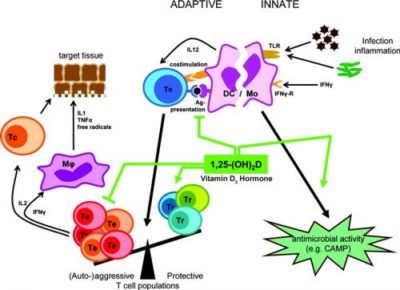The active hormone binds into the Vitamin D receptor (VDR) that is an essential component to most cellular and immune functions
The body needs the active Vitamin D3 hormone for improved immune and cellular functions and to aid in the absorption of calcium, which is essential in helping to form and maintain strong bones. Recent research has even indicated that active Vitamin D3 hormone provides protection against osteoporosis, high blood pressure, cancer, and several autoimmune diseases.

The body needs a continuous daily supply of stable Vitamin D3 to be converted into and maintain healthy levels of the active Vitamin D hormone.
One of the main benefits of maintaining optimum levels of the compound is that it regulates calcium (as well as phosphate levels) in the blood. Calcium is absorbed by the body (primarily in the intestines) with the help of Vitamin D. This helps the body maintain proper osterclast levels, which in turn promotes calcium resorption (as well as resorption of phosphate) to help maintain bone development as well as bone mass, which is also vital for healthy teeth.
By regulating calcium and phosphate levels (thereby preventing rickets in children and osteomalacia in adults), it is responsible for numerous biological functions such as neuromuscular function, increased bone density and development, and stimulation of electrical impulses for nerve cells, as well as muscle contractions.
References
- Brody J. (2102). Reasons that Vitamin D May Matter. New York Times, March 12.
- Clarke B. (2011). Medical Edge Newspaper Column. Mayo Clinic.
- Crissey S, Ange K, Jacobsen K, Slifka K, Bowen P, Stacewicz-Sapuntzakis M, Langman C, Sadler W and Kahn S. (2003). Serum concentrations of lipids, vitamin D metabolites, retinol, retinyl esters, tocopherols and selected carotenoids in twelve captive wild felid species at four zoos. The Journal of nutrition 133 (1): 160–6.
- Heaney R. (2003). Long latency deficiency disease: insights from calcium and vitamin D. American Journal of Clinical Nutrition 78:912-919.
- Institute of Medicine, Food and Nutrition Board. (2010). Dietary Reference Intakes for Calcium and Vitamin D. Washington, DC: National Academy Press.
- Jones G. (2008). Pharmacokinetics of vitamin D toxicity. Am J Clin Nutr. 88:582S-6S.
- NIH Office of Dietary Supplements Dietary Supplement Fact Sheet: Vitamin D. (2009).
- Vitamin D and Calcium: Updated Dietary Reference Intakes. Nutrition and Healthy Eating. Health Canada.
- Mayo Clinic. (2012). Vitamin D. http://www.mayoclinic.com/health/vitamin-d/NS_patient-vitamind
- Ross A, Manson J, Abrams S, Aloia J, Brannon P, Clinton S, Durazo-Arvizu R, Gallagher J, Gallo R, Jones G, Kovacs C, Mayne S, Rosen C and Shapses S. (2011). The 2011 Report on Dietary Reference Intakes for Calcium and Vitamin D from the Institute of Medicine: What Clinicians Need to Know. Journal of Clinical Endocrinology & Metabolism 96 (1): 53–8. doi:10.1210/jc.2010-2704.
- Sarubin F and Thomson C. (2007). The Health Professional’s Guide to Popular Dietary Supplements. 3rd ed. Chicago, IL. American Dietetic Association.
- Vieth R. (2006). Critique of the considerations for establishing the tolerable upper intake level for vitamin D: critical need for revision upwards. J Nutr. Apr; 136 (4): 1117-22.
- Vieth R. (1999). Vitamin D supplementation, 25-hydroxyvitamin D concentrations, and safety. Am J Clin Nutr. May; 69 (5): 842-56.
- Wolf G. (2004). The discovery of vitamin D: the contribution of Adolf Windaus. J Nutr 134 (6): 1299–302.
- Wolpowitz D and Gilchrest B. (2006). The vitamin D questions: how much do you need and how should you get it? J Am Acad Dermatol. 54:301-17.